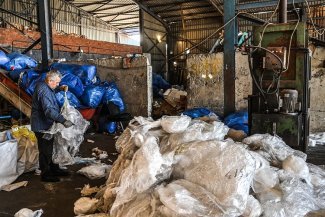
Naroumol Intharasit, a farmer from northern Thailand, saw improvements to her life when she started a cricket farm at her home seven years ago.
Seven years ago, Naroumol Intharasit, 44, noticed that a neighbour in her small village in north-east Thailand started to have more money than usual. Intrigued, Intharasit learned that her neighbour’s secret was simple. He had installed rudimentary concrete structures that housed small but very profitable inhabitants: crickets.
Eating insects is in style. According to international scientific organisations, these arthropods represent an alternative source of animal protein for an increasing population without the major environmental impact of the meat industry. And demand is booming.
According to consulting firm Global Market Insights, the world edible insects market is set to surpass US$710 million (€633 million) by 2024, an increase of 43.5 per cent over the US$55 million (about €49 million) recorded in 2017.
The benefits of insect farming don’t end with the environment. In Thailand, a country where insect consumption has traditionally been part of the local diet, farmers like Naroumol are taking advantage of increasing demand by setting up farms to breed these invertebrates. As a result, many have seen improved living conditions. “[Breeding] crickets makes me more money than anything else I produce,” says Naroumol, who also plants rice, fruits and a variety of vegetables, and keeps chickens and calves.
Thanks to her crickets, Naroumol earns an additional €400 (US$450) a month, almost 50 per cent more than the country’s minimum wage. “It’s a constant source of income, you don’t have to wait for a harvest. Every 45 days we have new insects to sell,” she says.
Insect breeding: a relatively recent phenomenon
According to a research article published in The Geographical Journal for which the authors conducted in-depth interviews with Thai cricket farmers, “cricket farming has improved the lives of many rural farmers in Thailand not only through the provision of an alternative income source, but through strengthening human and social capital.” The majority of these farmers, like Naroumol herself, live in economically depressed areas in the country’s north and north-east, regions that have lagged behind the rapid industrialisation of central Thailand.
“The incomes of farmers in rural areas who depend on a single crop can be very unstable,” says Afton Halloran, a consultant and one of the authors of the study. “Cricket farms allow them to fill these gaps in their income…with an activity that doesn’t require much of their time,” she adds. Like Naroumol, most farmers build their cricket farms underneath the stilt houses typical of the region “so they don’t have to leave home,” as Halloran explains. And since the cricket farms require just two and a half hours of work a day, “they don’t have to give up their other activities.”
Insect breeding has also contributed to the economic empowerment of women. Like Naroumol, most of the small-scale entrepreneurs in this industry are women who have achieved greater economic independence thanks to their farms. “Many women now earn more than their husbands,” says Halloran.
While eating insects is nothing new in Thailand, breeding them is a relatively recent phenomenon that dates back to the 1997 Asian financial crisis, which hit Thailand particularly hard and forced many urban workers to return to their home villages after losing their jobs. As Halloran explains, Khon Kaen University, the hub of higher education in north-east Thailand, began promoting insect breeding as an alternative income source in the wake of the crisis.
It was at the university that Naroumol learned how to care for her crickets. “I learned the basics there, but I’ve adapted them to the needs of my farm,” she says. “Now people approach me for advice,” she adds. This is one of the principles of the training that the university provides: farmers teaching other farmers in order to spread knowledge as quickly as possible and ensure that those who are unable to attend classes themselves can also learn. Thanks to this system of networking, today there are an estimated roughly 20,000 small and medium-scale farms in the country.
The dangers of an expanding industry
In recent years, the international community has been nearly unanimous on the subject of insect farming. According to information published by the Food and Agriculture Organisation of the United Nations (FAO), “Insects are everywhere and they reproduce quickly, and they have high growth and feed conversion rates and a low environmental footprint over their entire life cycle.”
However, according to Dr Elaine Fitches, an insect specialist with the United Kingdom’s Food and Environment Research Agency, the insect farming industry remains relatively poorly studied and its impacts are not yet fully known.
“We need to be very careful in assessing the entire life cycle,” she says. “[If we compare it to soya, fish oil or livestock], I’m certain that its environmental impact will be minor, but it won’t be zero.” One central concern is how the insects will be fed, especially if they are destined to be used as livestock feed, a growing trend. “It doesn’t make much sense to feed them soya if you can feed it directly to the livestock,” she explains.
Naroumol affirms that her entire production is sustainable and that she only feeds her insects with the vegetables she produces on her farm. “I don’t buy them at the market because the crickets die. I think they have insecticides,” she says. But Naroumol has seen some of her neighbours feed their crickets with feed bought from large-scale farms.
Despite its positive social impacts, the growing trend of insect farming also poses risks. As Naroumol explains, although demand has grown, competition has also increased and in the last three years prices have fallen by more than 15 per cent. “More and more neighbours are setting up farms, so buyers have more options.”
According to Halloran, the boom in the industry could also lead to greater concentration, with small-scale producers being unable to compete with large-scale operations. “If there’s an increase in demand it could attract larger companies which then displace small-scale producers.”
For the time being, Naroumol isn’t worried about the future of her farm. Crickets grow without much attention and are easily sold. “I think I could make even more money if I expanded my business,” she says. “But I have no more room here.”









